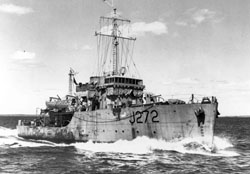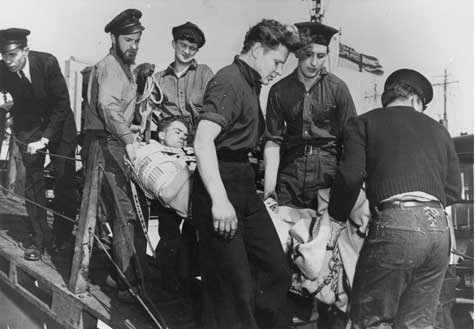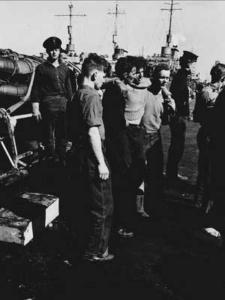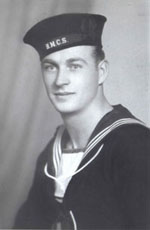Within Sight of Shore
The Sinking of HMCS ESQUIMALT
The last Canadian warship lost to enemy action in World War II was torpedoed in the approaches to Halifax in the morning of 16 April 1945, just three weeks before the end of the war. HMCS ESQUIMALT sank with heavy loss of life within sight of the coast. The survivors endured six hours in the frigid water before rescue arrived; only twenty-seven of the minesweeper’s seventy-one crew survived.
German U-boats, although outnumbered and outclassed by this stage of the war, fought to the end. The days when they had aggressively hunted in “wolf packs” on the surface had long since passed. Now they operated singly and stayed submerged. The loss of German bases in France and destruction of the supply U-tankers prevented U-boats from operating much farther afield than the east coast of North America.
U-190 had sailed from Norway on 21 February 1945 bound for the coast of Nova Scotia under the command of Lieutenant Hans-Edwin Reith, aged 25. It was his second cruise in command. U-190 travelled submerged to evade detection by radar or aircraft, using a schnorkel to breathe. Reith intended to operate in the approaches to Halifax where other schnorkel-boats had met with success. Just a few months earlier U-806 had sunk HMCS CLAYOQUOT there and escaped undetected in spite of a determined search. Poor sonar conditions off Halifax made the detection of submerged or bottomed U-boats difficult at the best of times.
U-190 arrived off Nova Scotia in early April and sighted two merchant ships on the 12th. Torpedoes missed both vessels which then disappeared from view. Reith moved in close to Halifax during the night of 15/16 April in search of targets.
HMCS ESQUIMALT sailed from Halifax during the evening of 15 April to make a routine anti-submarine patrol in the harbour approaches. ESQUIMALT was a diesel-powered Bangor-class minesweeper but operated primarily as an anti-submarine escort. She carried a 12-pounder gun, a 2-pounder, two 20 millimetre Oerlikon anti-aircraft guns, and seventy depth charges with a complement of seven officers and sixty-four men.
Lieutenant Robert MacMillan, DSC and Bar, RCNVR, the commanding officer, had orders to carry out the patrol and then rendezvous with HMCS SARNIA off Chebucto Head at Buoy “C” the following morning. Naval intelligence reports showed that a U-boat lurked in the approaches to Halifax, but had said the same for months without any definite sign of the enemy.
Towards dawn, Lieutenant John Smart, RCNVR, the watch officer, ordered the depth charge crews to their stations without sounding general action stations. The sea was calm with a long, low swell and visibility was good in the morning twilight. There was no need for radar. Halifax East Light Vessel and the shoreline were clearly visible. All eyes on the bridge were directed toward the vicinity of the stationary light ship, about three miles away. The depth charge crews stood down from the alert at 6:10 AM and the watch was relieved.
Nearby, U-190 heard the pinging sound of the minesweeper’s sonar which had failed to make contact. Below the surface, the Germans listened intently as ESQUIMALT circled above at 10 knots “and passed overhead two or three times”. When no attack followed, Reith took U-190 up to periscope depth for a quick look around. He observed the warship through the periscope at a range of between 1,000 and 2,000 metres.
It suddenly turned towards him and closed rapidly. Reith fired an acoustic homing torpedo from a stern tube. ESQUIMALT carried an anti-homing torpedo decoy, known as CAT gear, but was not streaming it. Nor was the minesweeper zig-zagging. The torpedo hit ESQUIMALT at 6:30 AM, ripping a gaping hole in the starboard quarter. The explosion knocked out the power instantly, preventing the radio room from sending a distress signal.
ESQUIMALT listed heavily to starboard, threatening to sink at any moment, and the emergency lighting failed. MacMillan emerged from below and made his way to the bridge where he gave the order to abandon ship. The signalman had been stunned by the explosion and no one else had the presence of mind to fire flares. The heavy list to starboard pushed the life boat under water before the crew could release it from the davits. They succeeded in getting four carley floats clear of the ship and plunged into the icy water after them.
Some men were trapped in the wreckage of the ship. Sub-Lieutenant Michael Kazakoff, RCNVR, of Kamsack, Saskatchewan, was asleep in his cabin when the torpedo struck. Outside his cabin all he “could see was a twisted mess of steel, with some glimmers of daylight shining through.” Shedding his life jacket, he crawled towards the daylight. He got pinned once but made it through the jagged steel, shredding his pants and suffering scratches and gashes all over his body.
Stoker Jack Ware, RCNVR, of Sandwick, BC, was in the engine room when the explosion rocked the ship. It knocked out the lights and thick smoke filled the room. He pulled himself out through an escape hatch that he had opened earlier for ventilation. Two other men got out of the engine room but only Ware survived the following ordeal; most of the crew made it into the water alive.
ESQUIMALT sank by the stern less than four minutes after she had been hit. One man escaped from the wreck as it slipped below the surface. Petty Officer Terrence Manuel, RCNVR, of Fredericton, a non-swimmer, forced his way through a hatch as water rushed in from above. He bobbed to the surface, lungs bursting, with the ship slipping away beneath his feet. Stoker Petty Officer Carl Jacques, RCNVR, of Truro, Nova Scotia, swam out to Manuel and pulled him and another sailor to a carley float. Jacques died from the exertion a short while later.
The survivors huddled together, fourteen or fifteen to a raft. Many of them were clad lightly and only those who had been on watch were wearing their protective weather suits. An aircraft flew overhead ten minutes later and sighted the carley floats but thought they were fishing boats and made no report. The sun rose higher in the sky, shining brightly. At first the men sang to keep their spirits up, later MacMillan led them in prayer. Gradually, they succumbed to the cold.
ESQUIMALT had been contacted by the Port War Signal Station at 6:27 AM, a few minutes before the torpedoing. The station could not raise her on the radio at 7:41 AM but did not suspect anything was amiss and the changing of the watch delayed further action. The forenoon watch operator did not try again until 9:01 AM when the failure to raise the ship was noted and passed up the line without any apparent sense of urgency. Two minesweepers, on their daily sweep, closed to within two miles at 9:30 AM but moved on without seeing the survivors or hearing their desperate calls for help.
Reith had watched his victim sink through the periscope and then put some distance between him and the position of the sinking. He moved into shallower water, reasoning that Canadian forces would expect him to move out to deeper water to escape.
ESQUIMALT did not appear at the rendezvous off Chebucto Head at 8:00 AM and HMCS SARNIA radioed her absence at 9:50 AM to shore authorities. Lieutenant Robert Douty, RCNVR, the commanding officer, then set about looking for the missing escort when Sarnia made sonar contact at 10:02 AM, 9.5 miles west of the position where ESQUIMALT sank. He now suspected that ESQUIMALT had been torpedoed and reported the contact to shore but his first duty was to counter-attack, not search for survivors. Sarnia carried out two depth charge attacks on the contact without effect. The Germans heard the explosions of the depth charges in the distance, too far away to cause any damage to the submarine. Douty lost sonar contact after the second attack and did not regain it during a brief search. At 11:25 AM he gave up the hunt and went to search for his missing consort.
Aboard the rafts, the numbers dwindled as the hours passed. One carley float had started out with thirteen men but they died from exposure one by one until only six were left. The six survivors, including Ware and Kazakoff, paddled their raft towards the Halifax East Light Vessel waving a white shirt. They had closed the distance to a half mile when the light ship and SARNIA noticed them. A boat from the light ship picked them up and they directed the minesweeper to the position of the other carley floats.
By now, the shore establishment in Halifax had finally come to life and realized that ESQUIMALT was missing. An aircraft, sent out to search, sighted the other rafts and flashed their location to Sarnia by signal lamp. Douty came upon the survivors at 12:30 PM, six hours after ESQUIMALT had been torpedoed. He lowered the whaler to pick up the men from one raft while he steamed toward the others. The minesweeper’s crew climbed down the scramble nets to pull the frozen and exhausted survivors from the icy water. SARNIA rescued twenty-one men (not including the six who reached the light ship) and recovered the bodies of sixteen others. The survivors were revived with rum aboard SARNIA and taken to the RCN hospital in Halifax. Most of them suffered swollen legs from immersion; few could walk. In total, twenty-seven men survived and forty-four died.
Rear Admiral L.W. Murray, RCN, Commander-in-Chief, Canadian Northwest Atlantic, organized a hunt for the U-boat. The RCN had deployed most of its escort strength overseas where the U-boat threat was the greatest. Now it scrambled to pull a search force together. Four minesweepers, HMCS ST BONIFACE, BURLINGTON, DRUMMONDVILLE, and KENTVILLE, began the search. No other forces were immediately available.
Support group EG 28, consisting of four frigates, was at sea escorting convoy HHX 350 about 120 miles south of Halifax. It would take several hours to arrive. In the meantime, ST BONIFACE organized a sonar search in a 20 mile square with the Halifax East Light Vessel as the datum point. The minesweepers found no trace of the enemy sub although it must have been within this area. U-190 lay on the bottom in only 24 metres, hidden by the poor sonar conditions off Halifax. EG 28 stopped to investigate an echo en route, which it later classified non-sub, further delaying its appearance at the scene of the attack.
The support group finally arrived before midnight and swept the area between the east light ship and Chebucto Head in line abreast, zig-zagging 2 miles apart, without success. False echoes from fish frustrated EG 28’s efforts the next day and on the 18th and 19th it had to be diverted from the search three times to screen incoming and outgoing convoys. The United States Navy’s Task Group 22.10 hunted farther afield while EG 27 relieved EG 28 on 19 April but no one found any trace of U-190. Murray called off the unsuccessful search on 21 April.
Lying low, Reith remained submerged off Halifax for seven days after the attack and later recalled that “Canadian search groups worked excellently” but did not suspect that he had moved into such shallow water. U-190 headed for home on 29 April, but never reached Germany. She received U-Boat Command’s signal for all submarines to surrender on 11 May, and broadcast her position in plain language. HMCS THORLOCK and HMCS VICTORIAVILLE arrived on the following day and escorted the U-boat to Bay Bulls, Newfoundland where the German prisoners were removed and then taken to Halifax for interrogation.
Many questions remained unanswered in the wake of the tragic loss of HMCS ESQUIMALT. Why was the minesweeper not zig-zagging, “contrary to very specific Halifax Patrol Orders”? Why was the anti-acoustic torpedo gear not in use? Standing patrol orders did not call for the streaming of CAT gear “but under the general orders in existence at that time there seems to be no doubt that C.A.T. gear should have been streamed”. The Board of Inquiry into the loss of HMCS CLAYOQUOT under similar circumstances four months earlier had emphasized the importance of deploying CAT gear. The only ones who could have answered these questions were the officers on watch that morning and neither of them, Lieutenant John Smart and Sub-Lieutenant Bruce Whitehead, RCNVR, survived. Still, the commanding officer’s terse testimony before the Board of Inquiry suggested that streaming CAT gear and zig-zagging were not standard practice in ESQUIMALT.
The failure to fire flares in the turmoil and panic of abandoning ship is perhaps understandable but undoubtedly cost the lives of many men. However, the decision not to employ radar that morning was of no consequence: the minesweeper’s outdated SW2CP radar was incapable of detecting a periscope or schnorkel. This radar was obsolescent and it is surprising that it was still the primary equipment in some RCN ships.
The inability of the sonar operator to detect the presence of the sub was also understandable because of the ship’s primitive type 128A set and the poor conditions in this area caused by the rocky bottom and severe water temperature layering. Later that summer HMCS BORDER CITIES and WINNIPEG searched the ocean floor for the wreck of the minesweeper with the latest sonar and echo sounder and failed to find it, even though the position of the sinking was known, providing some indication of the difficulties faced by a ship with outdated sonar.
The sluggish response of the shore establishment was also disturbing after six years of war. ESQUIMALT should have been on the harbour entrance radar plot but her sudden disappearance apparently caused no alarm. Why was the crew of the light ship oblivious to the torpedoing just three miles away? They did not see the carley floats in the water or hear the calls for help. Halifax’s first hint that something was wrong came at 7:41 AM when the Port War Signal Station failed to raise the minesweeper on the radio. Yet it was over four hours later that action was taken, over two hours after the radio watch operators had passed the word that there had been no reply to two calls.
Sarnia’s signal at 9:50 AM that ESQUIMALT had not appeared at the rendezvous and at 10:02 AM that a firm sonar contact had been obtained should have provoked an immediate response. Douty certainly suspected the worst. Still, it was not until about 11:30 AM that shore authorities figured out that something was wrong and took action. The reasons for the failure of the shore establishment are not clear. It had been several months since the last sinking off Halifax and personnel may have grown complacent with the end of the war obviously close at hand.
The Board of Inquiry into the loss of ESQUIMALT did not provide any answers. It glossed over the shortcomings of the officers and crew while neglecting those of the shore establishment entirely. The Board recommended that anti-submarine patrols be carried out by two escorts in company and stressed the necessity of zig-zagging in the approaches to Halifax. Further, it found that the emergency lighting system in Bangor-class minesweepers was inadequate and emphasized that regular inspections of carley floats must be made to ensure that they were fully equipped. Finally, it recommended that disciplinary action be taken against personnel who fail to wear adequate clothing at all times.
However, the Board did not censure any of the ship’s officers or crew, or any branch of the shore establishment for the debacle. The staff at Naval Service Headquarters in Ottawa was dissatisfied with the findings of the Inquiry. Commander David K. Laidlaw, RCN, Director of Operations, remarked, “Not a good inquiry. Several points were not explored, the most important probably being that ESQUIMALT was not zig-zagging….There seems to be little point at this time in pursuing these matters further unless disciplinary action against the Commanding Officer of the Esquimalt is contemplated”. It was not contemplated and, as the war in Europe was over, no further was taken except to inform the Commander-in-Chief, Canadian Northwest Atlantic, of Ottawa’s displeasure with the conduct of the Inquiry, thus bringing to an end a tragic episode in the history of the RCN.
The RCN commissioned U-190 a few days after her surrender and she served in the Canadian Navy for two years. Canadian naval aircraft sank the U-boat on 21 October 1947, Trafalgar Day, near the position where she had sunk HMCS ESQUIMALT. The periscope was removed from the sub and is still on display in the Crow’s Nest Officers’ Club in St John’s.
©Robert C. Fisher





 CFB Esquimalt Naval and Military Museum
CFB Esquimalt Naval and Military Museum
 CFB Esquimalt Naval and Military Museum
CFB Esquimalt Naval and Military Museum CFB Esquimalt Naval and Military Museum
CFB Esquimalt Naval and Military Museum CFB Esquimalt Naval and Military Museum
CFB Esquimalt Naval and Military Museum CFB Esquimalt Naval and Military Museum
CFB Esquimalt Naval and Military Museum CFB Esquimalt Naval and Military Museum
CFB Esquimalt Naval and Military Museum CFB Esquimalt Naval and Military Museum
CFB Esquimalt Naval and Military Museum CFB Esquimalt Naval and Military Museum
CFB Esquimalt Naval and Military Museum CFB Esquimalt Naval and Military Museum
CFB Esquimalt Naval and Military Museum CFB Esquimalt Naval and Military Museum
CFB Esquimalt Naval and Military Museum CFB Esquimalt Naval and Military Museum
CFB Esquimalt Naval and Military Museum CFB Esquimalt Naval and Military Museum
CFB Esquimalt Naval and Military Museum
 CFB Esquimalt Naval and Military Museum
CFB Esquimalt Naval and Military Museum CFB Esquimalt Naval and Military Museum
CFB Esquimalt Naval and Military Museum CFB Esquimalt Naval and Military Museum
CFB Esquimalt Naval and Military Museum CFB Esquimalt Naval and Military Museum
CFB Esquimalt Naval and Military Museum CFB Esquimalt Naval and Military Museum
CFB Esquimalt Naval and Military Museum CFB Esquimalt Naval and Military Museum
CFB Esquimalt Naval and Military Museum CFB Esquimalt Naval and Military Museum
CFB Esquimalt Naval and Military Museum CFB Esquimalt Naval and Military Museum
CFB Esquimalt Naval and Military Museum CFB Esquimalt Naval and Military Museum
CFB Esquimalt Naval and Military Museum CFB Esquimalt Naval and Military Museum
CFB Esquimalt Naval and Military Museum

 CFB Esquimalt Naval and Military Museum
CFB Esquimalt Naval and Military Museum CFB Esquimalt Naval and Military Museum
CFB Esquimalt Naval and Military Museum CFB Esquimalt Naval and Military Museum
CFB Esquimalt Naval and Military Museum CFB Esquimalt Naval and Military Museum
CFB Esquimalt Naval and Military Museum CFB Esquimalt Naval and Military Museum
CFB Esquimalt Naval and Military Museum
 CFB Esquimalt Naval and Military Museum
CFB Esquimalt Naval and Military Museum



 CFB Esquimalt Naval and Military Museum
CFB Esquimalt Naval and Military Museum



































 CFB Esquimalt Naval and Military Museum
CFB Esquimalt Naval and Military Museum CFB Esquimalt Naval and Military Museum
CFB Esquimalt Naval and Military Museum
 CFB Esquimalt Naval and Military Museum
CFB Esquimalt Naval and Military Museum